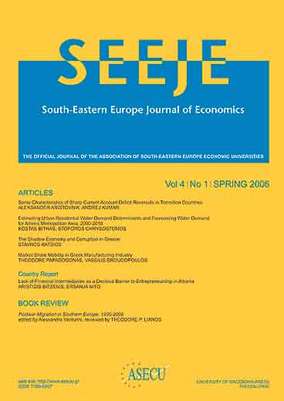The Greek economic structure in the 2000’s : a road to crisis?
Part of : SEEJE ; Vol.12, No.1, 2014, pages 35-64
Issue:
Pages:
35-64
Author:
Abstract:
The Greek economy has undergone a deep economic crisis, following the international financial disarray of 2008. It has been widely agreed that a number of signals conveyed the need to reconsider the long-run development strategy, but the Greek economy had been growing quicker than most of Europe at least since the 1960’s. Short-term difficulties need not have triggered a major crisis. The question is whether the economic structure by the early 2010’s explains such development. This paper searches for connections between that structure and the macroeconomic problems that the economy has encountered, regarding external deficits, employment, productivity and growth. Results suggest that structural change is a condition if Greece is to regain self-sustained growth in the long run.
Subject:
Subject (LC):
Keywords:
Greek economy, economic structure, sectoral performance
Notes:
Περιέχει πίνακες, σημειώσεις και βιβλιογραφία, Financial support by DGAPA-UNAM is gratefully acknowledged. The first version of this paper has been written while visiting the Latin Amerika Institut, Freie Universität Berlin (November, 2011)., JEL Classification: O52, C67, O11
References (1):
- Aroche Reyes Fidel (2000) Reformas estructurales y composición de las emisionescontaminantes industriales. Resultados para México. Serie Medio Ambiente yDesarrollo No. 24, Santiago de Chile: ECLAC-United Nations.Athanassiou Ersi (2009) “Fiscal Policy and the Recession: The Case of Greece” Reviewof European Economic Policy Vol. 44 No. 6, pp. 364-372.Brenke Karl (2012) “Die griechische Wirtschaft braucht eine Wachstumsstrategie” DIWWochenbericht Nr. 5, Vom. 1 pp. 3-15.Christodoulakis Nicos M. and Kalyvitis Sarantis “The Second CSF (Delors’ II Package)for Greece and its Impact on the Greek Economy. An Ex-ante Assessment Using aMacroeconometric Model” Economics of Planning, Vol. 31, No. 1, pp. 57-79.de Mesnard Louis (2002) “A Note on the Concept of “Net Multipliers” Journal of RegionalScience, Vol. 42 No. 3, pp. 545-548.Damaniakos Stathis (1997) “The Ongoing Quest for a Model of Greek Agriculture”Sociologia Ruralis, Vo. 37, No. 2, pp. 190-208.Devlin Robert and Ffrench Davis Ricardo (2005) “The Great Latin America Debt Crisis:A Decade of Asymmetric Adjustment” Revista de Economía Política, Vol. 15,No. 3., pp 117-142.Drakopoulos Stavros A., Theodossiou Ioannis (1991): “Kaldorian approach to Greekeconomic growth” Applied Economics, Vol. 23, No. 10, pp. 1683-1689.Carter Anne (1970) Structural Change in the American Economy. Cambridge (USA):Harvard University Press.García Muñiz Ana Salomé and Carvajal Ramos Carmen (2012) An extension ofMultilevel indicators: study of backward and forward linkages. Mimeo, Universidadde Oviedo.Gogos Stylanos, Mylonidis Nikolaos, Papageorgiou Dimitris and Vassilatos Vanghelis(2012) Greece 1979-2001: A (first) Great Depression Seen from the Basic RBCModel Working Paper Series 01-2012 Athens University of Economics and Business,Department of Economics.Griffith Jones Stephanie and Sunkel Octavio (1989) Debt and Development Crises inLatin America: The End of an Illusion. Oxford: Clarendon Paperbacks.Jomo Kwame S. (2003) Southeast Asian Paper Tigers? London and New York: RoutledgeStudies in the Growth Economies of Asia.Korres George (1996) “Sources of Structural Chang: An Input-Output DecompositionAnalysis for Greece” Applied Economic Letters Vol. 3, No. 11, pp. 707-710.Leontief Wassily (1944) “Output, Employment, Consumption and Investment” TheQuarterly Journal of Economics Vol. 58, No. 2, pp. 290-314.Leontief Wassily (1951) The Structure of the American Economy, 1919-1939. Anempirical Application of Equilibrium Analysis. New York: Oxford University Press.Leontief Wassily (1963) “The Structure of Development”, Chapter 8 in Leontief W.,Input-Output Economics, Second edition Oxford: Oxford University Press, 1986.Lequier Francoise and Blades Derek (2009) Comprendiendo las cuentas nacionales.Paris: OCDE.Mattas Konstadinos and Shrestha Chandra (1991) “A New Approach to DeterminingSectoral Priorities in an Economy: Input-Output Elasticities” Applied EconomicsVol. 23, No. 1, pp. 247-254.Mattas Konstadinos, Ciobanu Claudia and Psaltopoulos Demetrios (2010) “Prospects ofChanges in Regional Economic Structures since EU Accession” South-EasternEurope Journal of Economics Vol. 8 No. 1, pp. 55-72.Miller Ronald E. and Blair Peter D. (2009) Input-output Analysis. Foundations andExtensions, Cambridge: Cambridge Univesity Press.Mylonidis Nikolaos and Vassilatos Vanghelis (2009) Assessing the MacroeconomicPerformance of Greece in a Comparative Perspective. Paper presented at the 13thInternational Conference on Macroeconomic Analysis and International Finance.Crete.Papadimitriou Christos, Tzimos Iannis and Adamou Nikolaos (2007) The Measurementof Interindustry Linkages with Data Analysis Methods Paper presented at 16thInternational Conference on Input-Output Techniques.Papazooglou Christos (2012) “Is Greece's Export Performance Really Low?” EconomicBulletin. Bank of Greece, Economic Research Department, No. 32, pp. 27-37.Popov Vladimir (2010) Life Cycles of the Centrally Planned Economies: Why SovietGrowth Rates Peaked in the 1950’s. Working Paper 152 Centre for Economic andFinancial Research at New School.Smith Adam (1776) The Wealth of Nations. London: Wordsworth Editions (2012).Ugarteche Galarza Oscar (2013) Public Debt Crises in Latin America and Europe: TwoTales Social Science Research Network: SSRN: http://ssrn.com/abstract=2266881.Vamvakidis Athanasios The convergence experience of the Greek economy in the EU:lessons for EU accession countries. Successes and failures in real convergence.National Bank of Poland, 23-24 October 2003.




